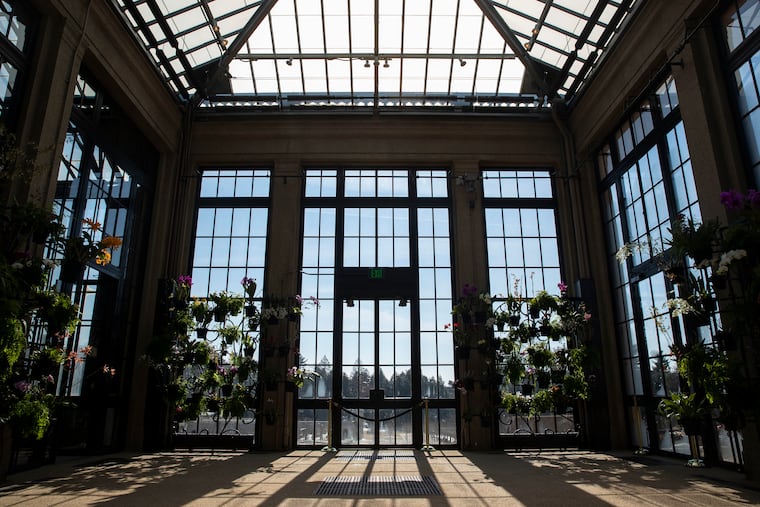A tour of the newly renovated Longwood Gardens Orchid House
Closed for about a year, the refurbished Orchid House is the first fruit of a massive renovation and reconstruction project.

The most extensive renovation and construction project in Longwood Gardens’ history will reach a small but significant milestone this weekend when the horticultural center’s much-admired Orchid House, completely refurbished and reconfigured, reopens on Saturday, Feb. 26.
Located on the west end of the main conservatory, the Orchid House is only about 1,400 square feet – diminutive in the context of the entire $250-million, 17-acre project. But it serves as an essential amuse-bouche, an appetizer cleansing the palate in preparation for what’s to come, probably toward the end of 2024, officials say.
Until then, there is the Orchid House, a bit of Longwood that is “grounded in the legacy of our founder,” Pierre S. du Pont, said Longwood director and chief executive Paul B. Redman. And now it is completely redone as part of the massive Longwood Reimagined project.
“He and Mrs. du Pont built this with great intentionality for this space to be used for orchids,” Redman said, noting that construction on the original space began in 1921.
“This is his legacy,” said Redman “It’s about horticultural display and education and training. And that’s what this room and the rest of the conservatories have always been used for.”
Longwood, the former du Pont estate, sprawls over 1,000 acres of rolling Chester County countryside in Kennett Square.
The refurbished Orchid House, which has been closed for about a year, will display about 300 orchids when it reopens on Saturday, a number that will grow over time, said Greg Griffis, senior horticulturalist, orchid expert, and curator of the continuously changing orchid exhibit.
Some of these orchids are quite old.
Paphiopedilum “Beatrice,” a small yellow plant that might be called retiring were it not a dazzling orchid, dates from at least the 1930s, and possibly much earlier, Griffis said.
“We have probably 60 or so plants that we know were physically here when Pierre [du Pont] was alive, many of them arriving in the ‘20s and ‘30s,” he said.
Griffis said he once remarked to a colleague that the Longwood orchid collection “needs a 100-year plan.”
“And when we built this, the folks who built it, built it for 100 years,” he said, standing in the Orchid House. “Nothing in here should fail before 100 years comes up because the plants can last for potentially as long as we can care for them.”
He gestured toward the “Beatrice.”
“That plant should hopefully be here 100 years from now also,” Griffis said. “In the UK, there are orchids that are 200 years old. We now have the documents for most of the provenance of our oldest ones and we know they came from the ‘20s and ‘30s.”
Redman said the Orchid House restoration and reconstruction have been comprehensive. All 1,416 panes of glass in ceiling and walls have replaced. The historic iron and bronze work has been refurbished and new iron trellises — inspired by the old — have been fashioned to bring greater flexibility to the display.
Even the concrete used in the original Orchid House was deemed historic and its stony mosaic pattern has been replicated and replaced by John Milner Architects. Milner, preservation specialists, also installed the new glass roof, the glass walls, and new lighting.
Because of the greater flexibility provided by the new trellises, Griffis said he will be able to swap out plants on a daily basis. In two greenhouses not too far behind the conservatory, there are about 5,000 orchids serving as continuously growing stockpile for use in replenishing and modifying the display.
“I have a team of almost 20 volunteers whose sole job is just doing that so we’ll continue to refine our sense of how we accomplish what we’re looking for, but it should never feel crowded,” he said.
“Every weekday, we’ll be in here changing out,” said Griffis. “The flexibility that we have means that we can take more time to really nuance the display and highlight important plants, so we have allotted more help and more time to actually do those changes.”
The Orchid House restoration alone is budgeted at roughly $5.4 million, said Redman.
Meanwhile work is well underway on construction of a new 32,000-square-foot West Conservatory, directly to the west side the Orchid House. To the south, earth-moving equipment has cleared away a massive area for a new restaurant and other food operations. Other structures are similarly in mid-air looking to land two years out at most.
Redman stood for a moment watching the restaurant construction out the window of the Orchid House. A giant crane slanted over the rising conservatory; fences and concrete foundation walls angled every which way.
Was he surveying the labyrinthine domain?
“I don’t know about domain,” Redman said. “But I’m in awe of the work that’s happening here. Isn’t it amazing? Just the scale of it is amazing.”